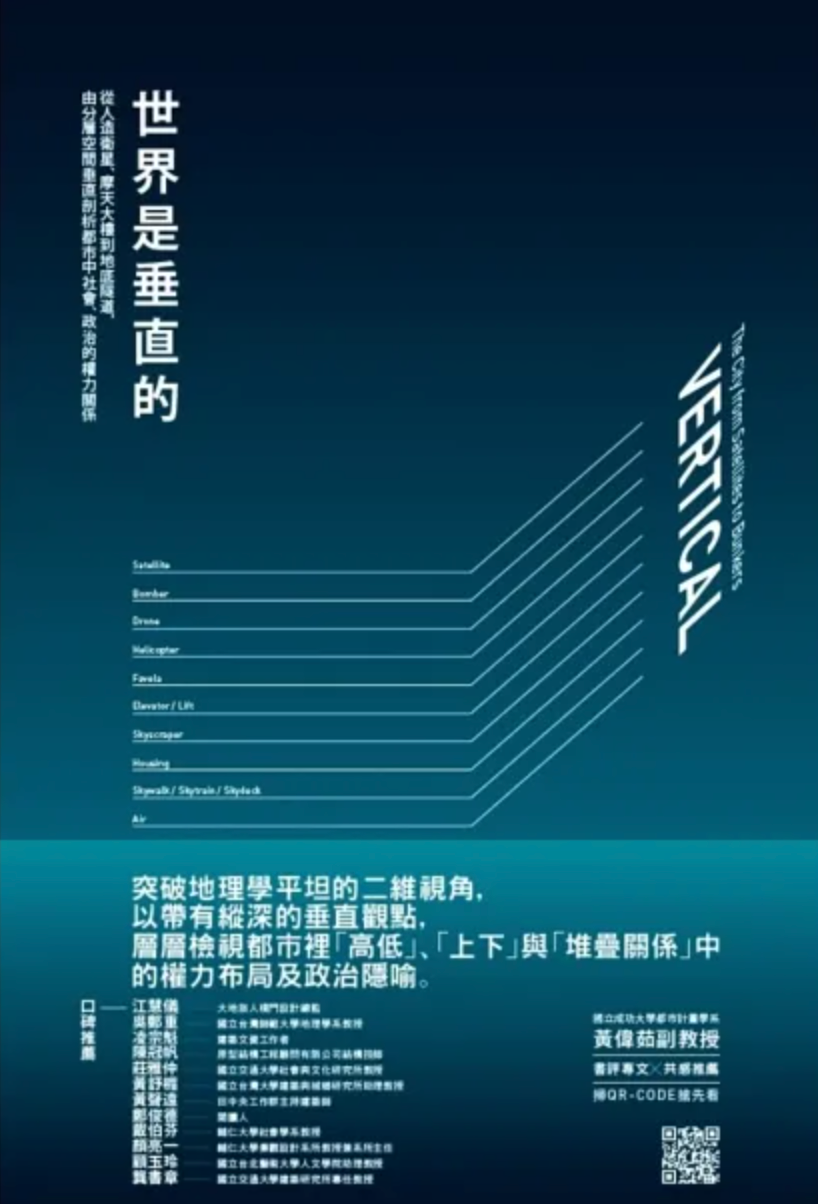1
/
of
1
The world is vertical: From artificial satellites, skyscrapers to underground tunnels, a vertical analysis of social and political power relations in cities from layered spaces
The world is vertical: From artificial satellites, skyscrapers to underground tunnels, a vertical analysis of social and political power relations in cities from layered spaces
Regular price
MOP$183.00
Regular price
Sale price
MOP$183.00
Unit price
/
per
Couldn't load pickup availability
▌When we are used to seeing the world on a flat surface, what do we miss or mistake? ▌
Urban geographers from the University of Newcastle lead readers starting from high up, gradually descending along the vertical axis, and going deep beneath the earth's surface;
From flying objects in space and atmosphere hanging above the city, to buildings, shanties and various elevated buildings in the city,
Going deeper into underground tunnels, bunkers and sewers──analyzing human rights, justice and social issues hidden in the vertical differentiation of space.
Even with the rapid advancement of technology, from paper maps to Google Maps, maps are still used to adopt a bird's-eye view.
Drawing with flat color blocks and lines has always followed the old convention,
Continuing the cartographic tradition that served European navigation, colonial activities, and imperialism.
For hundreds of years, this has made our imagination of world geography unconsciously narrow and flat.
However, modern technology has brought a variety of new technologies, such as artificial satellites, aircraft, drones, etc.
Everything is more and more closely affecting human daily life; on the other hand, construction methods continue to advance,
We are increasingly inseparable from various elevators, skyscrapers, corridors, underground tunnels, sewers and other facilities in the city.
Humanity's urban life is becoming increasingly "rich".
But what are the aerial colonizations, vertical height hegemonies, and
Is the phenomenon of "spatial injustice" rising from the ground quietly brewing in the city we live in?
And what are the social implications of continuing to excavate cellars, sewers, bunkers and even mines deep underground?
The author of this book, Stephen. Professor Graham combines his 25 years of accumulated interdisciplinary academic training with his expertise in the sociology of technology,
The professional vision developed in the urban planning and geography circles uses this book to deeply study and explore these phenomena:
In addition to reviewing the stereotypes and perspectives that most people have had on cities in the past, this book also adds more layers and depth to readers' horizons.
The author reminds us that we should always pay attention to the complex connections between power, technology, politics and urban vertical stratification.
We should not forget the importance of humanistic care and critical thinking at this moment and in the development of global cities.
Drawing with flat color blocks and lines has always followed the old convention,
Continuing the cartographic tradition that served European navigation, colonial activities, and imperialism.
For hundreds of years, this has made our imagination of world geography unconsciously narrow and flat.
However, modern technology has brought a variety of new technologies, such as artificial satellites, aircraft, drones, etc.
Everything is more and more closely affecting human daily life; on the other hand, construction methods continue to advance,
We are increasingly inseparable from various elevators, skyscrapers, corridors, underground tunnels, sewers and other facilities in the city.
Humanity's urban life is becoming increasingly "rich".
But what are the aerial colonizations, vertical height hegemonies, and
Is the phenomenon of "spatial injustice" rising from the ground quietly brewing in the city we live in?
And what are the social implications of continuing to excavate cellars, sewers, bunkers and even mines deep underground?
The author of this book, Stephen. Professor Graham combines his 25 years of accumulated interdisciplinary academic training with his expertise in the sociology of technology,
The professional vision developed in the urban planning and geography circles uses this book to deeply study and explore these phenomena:
──After the artificial satellites silently hanging in space have popularized geographical information, what will be the next step for the technological elite and the powerful? Seeking to further monopolize supreme power in the hands of a few people? Further surveillance and privacy violations? Militarization of space?
──Humankind's desire to constantly "go up to poverty" by building skyscrapers is just to achieve spectacle and hype-style fetishistic satisfaction? Or perhaps, out-of-control global speculative capital is using skyscraper real estate to plunder ill-gotten gains and erode the residence rights of others...
──The popularity of elevators has allowed us to witness the continuous development of this technology: from landscape elevators, high-speed elevators, and even the latest nuclear-powered elevators. In this kind of vertical transportation, what kind of power structure does "directly reach the destination" or "stop at every level" imply?
──The fantasy of an odorless and clean city closely adheres to the core of the modern home concept; in this, the sewer plays an important role. How is the psychological experience related to the vertical human body, excretion, and metabolism subtly related to the vertical dimension of urban structure?
──The wealth scavenged from the mines drives the city's high-rise buildings to climb toward the dizzying skyline day by day, and also creates a wealth of money and power for related companies. Why can the downtown buildings where these companies and commercial offices are located be described as "an upside-down mining scene"?
──Humankind's desire to constantly "go up to poverty" by building skyscrapers is just to achieve spectacle and hype-style fetishistic satisfaction? Or perhaps, out-of-control global speculative capital is using skyscraper real estate to plunder ill-gotten gains and erode the residence rights of others...
──The popularity of elevators has allowed us to witness the continuous development of this technology: from landscape elevators, high-speed elevators, and even the latest nuclear-powered elevators. In this kind of vertical transportation, what kind of power structure does "directly reach the destination" or "stop at every level" imply?
──The fantasy of an odorless and clean city closely adheres to the core of the modern home concept; in this, the sewer plays an important role. How is the psychological experience related to the vertical human body, excretion, and metabolism subtly related to the vertical dimension of urban structure?
──The wealth scavenged from the mines drives the city's high-rise buildings to climb toward the dizzying skyline day by day, and also creates a wealth of money and power for related companies. Why can the downtown buildings where these companies and commercial offices are located be described as "an upside-down mining scene"?
In addition to reviewing the stereotypes and perspectives that most people have had on cities in the past, this book also adds more layers and depth to readers' horizons.
The author reminds us that we should always pay attention to the complex connections between power, technology, politics and urban vertical stratification.
We should not forget the importance of humanistic care and critical thinking at this moment and in the development of global cities.
ISBN:9789862358689
出版:臉譜
分類:Book Selection Exhibition─Walking around the city, using books to guide the way,Text


